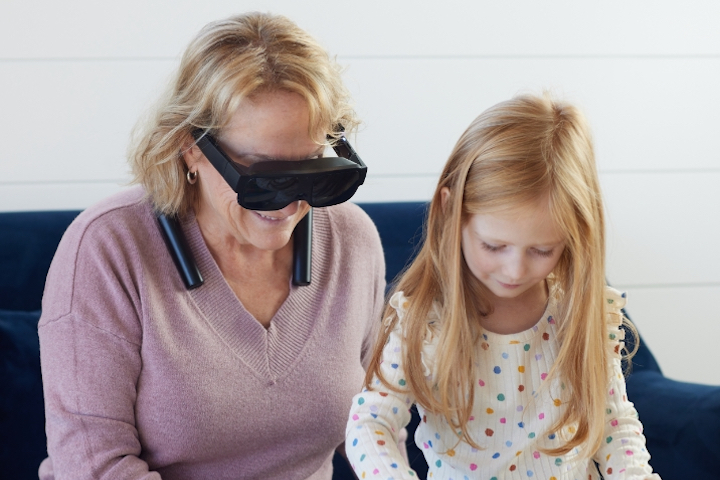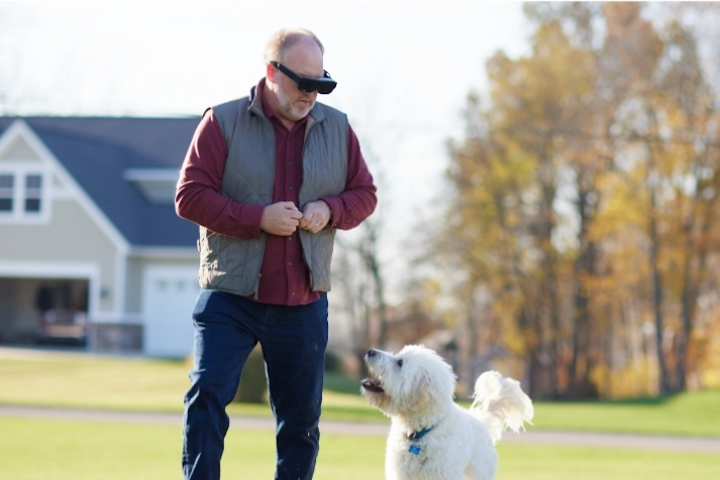“I’ve never seen anything that impacts the individual and their caregivers around them the way this does. It’s amazing,” eSight’s head of marketing Roland Mattern told me during a video chat at CES 2023 about the company’s latest product, the eSight Go.
He was describing the incredible changes he has witnessed in people’s lives when they use eSight smart glasses, which help partially sighted people see more clearly. It’s life-changing technology, and the aim of its latest model is to help more people than ever.
What are eSight Go smart glasses?

eSight’s smart glasses are designed to help people with central vision loss regain their vision, and they do so using a combination of cameras, OLED screens, and clever software algorithms. I first came across eSight at CES in 2018 and was amazed by what they could do when I spoke to someone who had used them for a while. Five years later, the new eSight Go model shows just how much the technology has moved on — and how much more difference it can potentially make to people’s lives.
“[The eSight 4] isn’t subtle, so some people are shy to wear it in everyday life because it puts a bit of a spotlight on them,” Mattern said about the company’s current smart glasses. “For the next generation product, we wanted to provide the same technological capability in a smaller format.”
The eSight Go smart glasses are far more subtle than before, looking like a large pair of sunglasses. Mattern explained how this has been achieved:
“It’s lighter, smaller, has a better camera, a better chip, and easier to navigate software. All the things are one level better. We’ve taken the battery out of the device, which was, in part, what has made it so small and light. You wear the batteries around your neck and connect it with a short wire [to the headset]. On previous generations, you had a long wire to a suitcase on your hip, and it could get caught on things as you walked around. Now it’s not obstructive at all.”

The result of all the changes is the eSight Go weighs 170 grams, a considerable reduction in weight compared to the eSight 4, which weighs 560 grams. For comparison, the PlayStation VR headset weighs about 600 grams. But the updates don’t stop there.
“The big thing for me, the technological advancement, is it has a really, really good image stabilization system in it. One of our coaches drove with his wife down to CES from Los Angeles and he could actually read in the car with the device on, which he wasn’t able to do wearing eSight 4.”
How does eSight work?
At this point, you’re probably wondering how a pair of smart glasses can help someone see. Mattern explained who will benefit from eSight’s glasses, and how they work:
“The patients that we’re trying to help have lost their central vision through a variety of diseases, and the most common is age-related macular degeneration. The macular’s function is to give us that sharp, central vision that we use for reading and for focusing on things.”
According to Mattern, 3 million people in North America have central vision loss due to acute macular degeneration (AMD), a figure expected to double by 2050.

“The way eSight works is the camera picks up stimulus that the wearer can no longer perceive because their central retina is damaged. The software allows the user to magnify the brightness, and to use contrast or color filters so any photoreceptors in the center of the eye that are still viable are triggered because now the ‘image’ is larger and brighter and a bigger stimulus, if you will. The photoreceptors take that central image and send it to the brain, where it separates what should be a central image and a peripheral image, to shrink that blind spot out of the way.”
It sounds pure science fiction when put like this, but it’s absolutely not fiction. What does it all mean when someone puts the eSight glasses on? Mattern explained what it’s like for someone who has lost central vision:
“If I’m looking at your face, all of your facial features will just be a blur of skin tone. Maybe I’ll see the top of your head and maybe the top of your chest. But in the middle is a blur. I know you’re there, but I wouldn’t recognize you,” Mattern said. “When you put eSight on, without any manipulation, you realize, ‘Oh, there’s a set of eyes there, and there’s a nose, and there’s a mouth’. Then as you use magnification and contrast and whatever settings are ideal for the user, the face appears. Some of our users will tell you they can count your eyelashes because they can zoom in and it’s that clear. It’s quite remarkable.”
Using eSight in the real world
Hearing how eSight works from a technical point of view is fascinating, but it’s hard to understand the impact it can have on someone’s life. Mattern talked about someone he works with who has been using the glasses, and the speed with which it becomes transformational.
“One of the users that I’ve got quite close to is Gary, and he lost his vision in his fifties due to AMD, which is quite young, and he lost it very quickly. He had a motorcycle, he had an RV, he was very active, but very quickly all those things were taken away from him. For five years, he didn’t really have central vision, and he really withdrew socially because he couldn’t do the things he loved. He was at a conference that eSight was attending and his wife convinced him to try, even though he had a ‘we tried everything and nothing works’ attitude. He looked through it and there was silence from him. He was asked if it worked, and he said, ‘I can see your face.’ He looked around and said, ‘I can see everybody’s face.’”
Mattern explained that although the eSight technology can’t be for everyone, with the right screening, they have a good success rate, and that all it usually needs to be functional with the glasses is an hour of training. When someone buys eSight, it comes with five hours of training included, but most people end up only needing three hours in total to be accomplished. The video below tells more stories from people who use eSight and features the eSight 4 headset.
How is eSight controlled? Most of it is automatic, including focus, exposure, contrast, and brightness. However, by using buttons on the arm of the glasses, all these can be manually changed, much like putting the camera on your phone into Pro mode. Then there’s the magnification, which is useful to switch between looking at objects close-up, and then suddenly needing to see something long-distance. The eSight Go has a 24x magnification capability.
Truly transformational
Hearing all this, the difference eSight can make is obvious, but this is not a cheap piece of technology; hardly a surprise given the research and development necessary to create such a device. The goal with eSight Go isn’t only to make it more portable, more wearable, and more technically capable, it’s also to make it more affordable and accessible too.
“eSight started off life at $15,000,” Mattern said. “Then it dropped to $10,000, and the eSight 4 is $6,950, plus you get a $1,000 discount if it comes through a physician referral. Our goal with the eSight Go, although we’re still at the prototype stage and we’re still tweaking things, is to keep it as inexpensive as possible, to make it accessible to most people. We would like to have it significantly less expensive.”
Mattern summed up what eSight means to people perfectly, and helped those of us who don’t currently need a product like it understand its transformational nature:
“There are really two kinds of experiences with eSight, both of which are incredibly impactful on the individual. One is about doing things and seeing things for the first time, and the other is for those individuals who gain all of their passions and hobbies and activity of living back. It really has a huge human impact.”
The company intends to release eSight Go around August this year, while the eSight 4 is available now.
Editors' Recommendations
- The best and coolest tablets we’ve seen at CES 2023
- At CES 2023, it’s not the software that’s killing Android smartwatches
- The quirkiest and most unusual mobile tech at CES 2023
- CES 2023: This Android phone can send satellite text messages to your iPhone
- Android phones are stealing (and beating) the iPhone 14’s best feature at CES 2023




